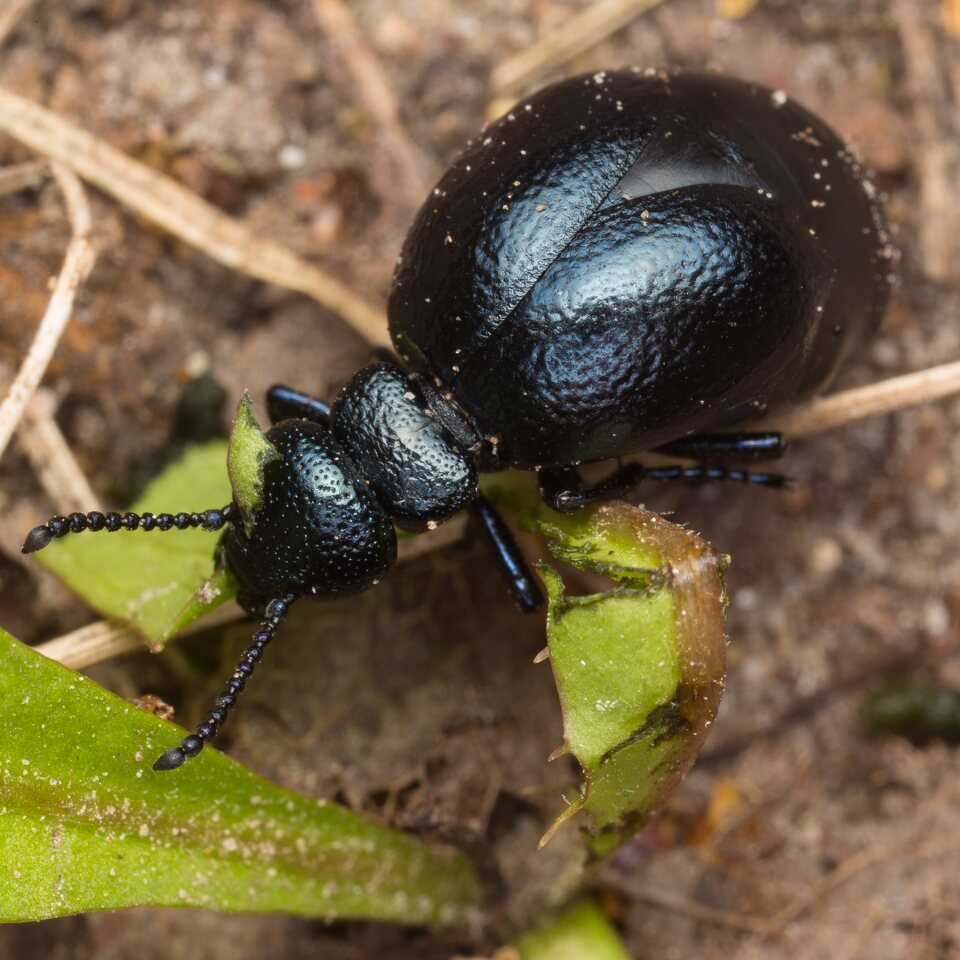
Meloe proscarabaeus · paprastasis gegužvabalis
- black oil beetle
- Schwarzblaue Ölkäfer, Schwarzer Maiwurm
- paprastasis gegužvabalis
- tumšā eļļasvabole
- oleica krówka
It occurs throughout the Palaearctic region from Portugal to the far east of Russia, extending north into the UK and southern provinces of Fennoscandia, it is present across North Africa and the Near East and on most Mediterranean islands. It is generally abundant in warmer southern latitudes and more local and sporadic in the north where it has suffered a general decline over recent decades along with various host species of solitary bee. Adults are active from early in the year, February or March and persist into May or early June, typical habitats are unimproved grassland and coastal cliff tops rich in wild flowers but they occasionally occur in open woodland; they may be found in warm weather among long grass or on various yellow flowers where they feed on foliage and flowers. Mating occurs from March and pregnant females excavate burrows in loose dry soil in which to oviposit, usually near to host nesting sites, this generally takes a couple of hours to complete and occurs a few weeks before the hosts become active, up to 1000 bright yellow eggs are laid in a single mass at the base of the burrow which is then back-filled with the excavated earth. Oviposition is a frantic business at this time and several females may be observed excavating in a small area, sometimes even unearthing other burrows made by other females. Eggs hatch after a couple of weeks and the first triungulin larvae emerge from the soil to coincide with the emergence of their host bees but the beetles continue to oviposit into April or May and triungulins may be found into June, they emerge from the soil together in large numbers and are immediately very active, running on the surface and climbing plant stems to find flowers and at this time flowers may be found covered in hundreds of the tiny larvae. Triungulins will attach to any visiting insect and be carried away, usually in numbers, but some will soon become attached to the correct host, which includes various species of Andrena, Colletes, Halictus, Osmia, Eucera (etc.), and be transported back to the nest. Once in the nest the triungulins leave the host and invade the larval cells where they feed voraciously on honey and consume any host eggs present before entering an inactive phase, they then moult and appear as a scarabaeiform larvae which will complete its development within the cell, or sometimes invade adjacent cells as well, and overwinter as a specialized stage before a final scarabaeiod form emerges early in the year to construct a pupal chamber or continue feeding for a while before doing so. In at least some species this inactive overwintering stage may survive over several seasons in response to environmental conditions but it is not known whether the present species can do this. With a little experience adults may be identified in the field and so they are best recorded by simple observation rather than sweeping or any other invasive or potentially damaging method.
The large but very variable size 13 to 32mm, overlapping elytra which expose much of the abdomen and black or bluish black colouration are quite unique. M. proscarabaeus is very similar to M. violaceus, but distinguished by the form of the pronotum which is quadrate or slightly elongate, is smooth (without a transverse furrow) in front of a straight basal margin and has a small indistinct rounded tooth at the posterior angles. Males have modified antennae; segments 3-5 are dilated and flattened and the joint between segments 6 and 7 is angled, giving a distinctly ‘kinked’ appearance, female antennae may also be kinked but to a much lesser degree and the segments are unmodified. Other distinctive features of the present species are the strongly punctured and flattened pronotum and the roughly sculptured elytra, most specimens are black with a blue or violet reflection but completely black specimens are not uncommon and in some the forebody is more strongly coloured than the elytra and abdomen. Triungulin larvae are mostly pale yellow and so are readily separated from those of M. violaceus which are mostly black.
Lervos parazituoja laukinių bičių urvuose. Dydis 13-27 mm. Kūnas tamsiai mėlynas, beveik juodas. Antenos per vidurį sustorėjusios. Priešnugarėlė kvadratinė. Galva ir priešnugarėlė su stambiais taškais, antsparniai – su stambiomis raukšlėmis arba tankiai taškuoti.
‥
0 comments
Add a comment
Comments